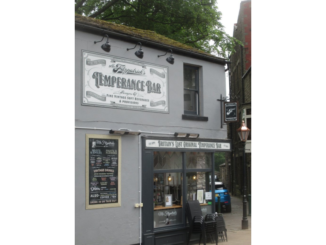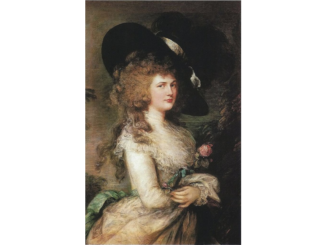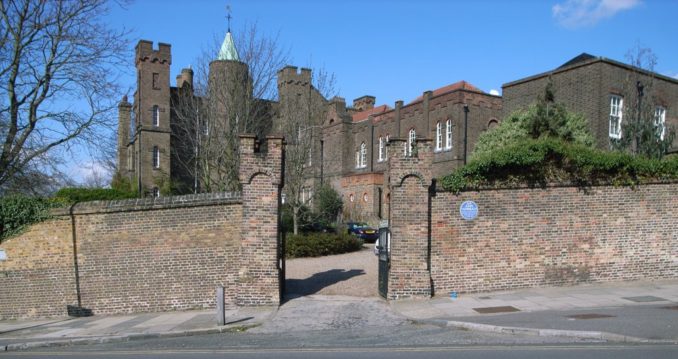
Steve Cadman from London, U.K., CC BY-SA 2.0, via Wikimedia Commons
Its walls and towers stare down – rather snootily it could be said – from Maze Hill, over the lesser buildings clustering round its feet on the edge of Greenwich Common. Opposite, Canary Wharf’s ghostly-looking, ugly, johnny-come-lately high-rises seem to cock a snook back in turn across the lower reaches of the Thames towards its historic presence.
This is Vanbrugh Castle, a gothic-looking building on the edge of Greenwich Common in south-east London. It’s built of warm, dark, almost tweedy-looking brick and was constructed by Sir John Vanburgh for his own occupation in 1718/19. Faintly Scots baronial in style, yet preceding that movement by a good hundred and fifty years, it is now divided into four luxury apartments. The last time one of them came on the market, it sold for a cool £2.75 million.
This one-time family home, now in multiple occupation, came into being at the behest of one of the most influential men of his day – one who not only added to our cultural life and what we now call the built environment, but played his part in changing the whole structure and direction of the United Kingdom.
So what was he like, the architect (or surveyor, as they were then called) of this magnificent residence? Born into a family of what was described as ‘sugar-bakers’, Vanbrugh was once thought to have had humble beginnings. A modern biographer refuted this, showing that sugar-baker did not mean sweetshop-owner or confectioner, as had been assumed since an 1840 book mentioned it. Sugar-baking was actually the industrial process of refining raw sugar from the West Indies, a lucrative trade which could bring in as much as £40,000 pa in those days – the rough equivalent of a staggering £4.8 million pa today. (Note that ‘could’ does not mean ‘did’). On his mother’s side, moreover, he was related to several earls and a duke.

Godfrey Kneller, Public domain, via Wikimedia Commons
His kit-kat portrait (a kit-kat, named after the Kit Kat Club in which these works were displayed, is a portrait by Godfrey Kneller showing the top half of the body, plus hands) depicts the arched eyebrows and full mouth of a confident, long-nosed, pale-complexioned man, the tones of his rich tawny velvet coat echoing his long auburn curls. A wig, of course: every man of fashion shaved his head and wore a wig in those days, however thick his natural hair. A white lawn or linen shirt, complete with pearl buttons and a medallion, complete the ensemble.
The family moved from London to Chester, and when his schooling was completed Vanbrugh most likely worked in trade and then went ‘out East’ to India – where his uncle had been a provincial governor for the East India Company – before returning to serve with the Earl of Huntingdon’s regiment of foot from January to August 1686. Then things begin to get a little more interesting.
The next we hear of him, the 24 year old is in prison in France on a spying charge. Reports that he had been studying architecture there are now thought to be false. Exactly what his mission was remains mysterious, but it definitely was connected to the attempt to get rid of the Catholic autocrat James II and replace him with the Protestant champion of parliamentary democracy, William of Orange.
The Whig Kit Kat Club, although on the face of it a convivial gentleman’s dining and socialising venue, in fact seems to have played a large part in these undercover negotiations, and Vanbrugh was arrested in Calais after having delivered messages to William in the Hague just two months before the House of Orange finally ousted the last of the Stuarts in the so-called Glorious Revolution of 1688.
Incarcerated for some four and a half years – partly in Calais, partly at the château of Vincennes and partly in the Bastille, some of it at his own expense – Vanbrugh emerged into the daylight in his late twenties as part of a prisoner exchange. When finally allowed to return to London, he proceeded to join the Navy, taking part in an active engagement against the French at Brest.
Despite his rather grand connections, and a possibly wealthy family background, money seemed to run through Vanbrugh’s fingers – maybe being one of a family of nineteen siblings did not help. For a time, he took the post of Herald At Arms (a government officer responsible for coats of arms, arranging state ceremonies and the conservation of heraldic and genealogical archives), a position which he sold; at another time, he sank a considerable amount into business ventures like the Haymarket Theatre, losing it in the process.
His inventive imagination even turned its attention to creating the currently fashionable witty, outspoken and controversial dramas himself, resulting in hits like The Provoked Wife and The Relapse, which challenged the conventional wisdom re a wife’s supposed submissive role in marriage. Vanbrugh’s success as a playwright was the basis of more than one actor’s career, but sadly for him public taste was already veering away from the previously popular bawdy Restoration comedies towards something which laid more emphasis on virtue and morals.
Although continuing with this thread of his life by virtue of being involved in theatre management, dramatic production and translation of play texts, Vanbrugh now was determined to branch out. His constructive powers, having already had an intellectual work-out re the nation’s constitution and the capital’s cultural life, turned from works of the imagination to works of a rather more solid and concrete nature. Now he would build – not castles in the air, but real ones.
Perhaps his best-known projects are Blenheim and Castle Howard, which along with other monumental schemes like Seaton Delaval gave rise to Vanbrugh’s reputation for having created the short-lived architectural style which became known as ‘the English Baroque’.
Somehow, Vanbrugh’s charm and ability persuaded patrons like the Duke of Marlborough and the Earl of Carlisle away from previously acclaimed architects and towards his ambitious but untested self, working alongside Nicholas Hawksmoor (famous for his London churches) as he created his plans and designs. Doubtless the patrons’ being fellow Kit Kat Club members didn’t hurt.
His constructions’ decorated grandeur and imposing forms, taking the eye both upwards and outwards to create a sense of unparalleled space and haughtiness, were not always appreciated by everybody: some commentators found them clumsy and awkward. The castles he made attempted to unite in stone what could perhaps be summed up as the three ‘P’s of his Whig philosophy.
The first P was patriotism, which in this context usually meant anti-French feeling, displayed for example in the magnificent incorporation of a thirty-ton marble bust of the defeated Louis XIV positioned above Blenheim Palace’s south portico above the slightly clumsily-worded motto, ‘Europae haec vindex genio decora alta Britanno’ (‘The avenger of Europe dedicates these lofty adornments to the genius [ie spirit] of Britain’). Vindex is an interesting word – it is usually translated as ‘protector’ or ‘defender’. But, originally, this Latin term was a word for a tax-collector, so it carries some sense of ‘someone who assesses and collects what is due’. Perhaps a nearer translation might be ‘score-settler’. The bust itself was taken from the city gates of Tournai by the Duke of Marlborough after its sack in 1709.
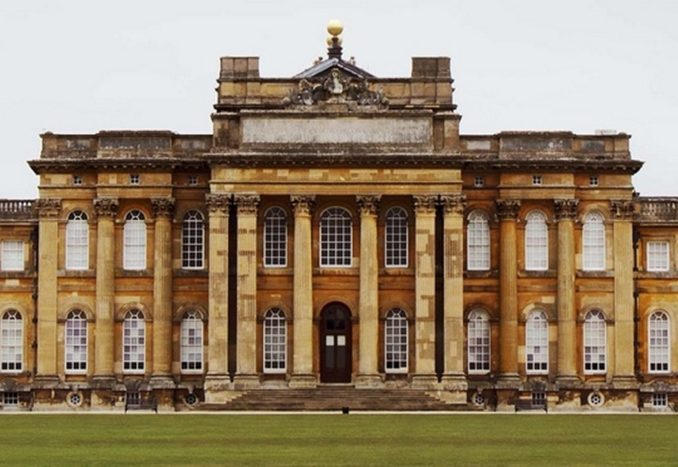
Blenheim_Palace,_south,_2013.jpg: mediaoverflowderivative work: Nev1, CC BY-SA 2.0, via Wikimedia Commons
Blenheim, named after the duke’s famous victory at Blindheim and probably now best known as the birthplace of Winston Churchill, is the only non-royal or non-episcopal seat in England to be allowed to bear the name of ‘palace’.
Sadly, this whole building project collapsed into political infighting and financial squabbling, and Vanbrugh – with his grandiose ideas – was eventually sacked, while the more thrifty duchess supervised the works herself.
The second P stood for parliament – Britain’s parliamentary democracy, now under a new monarch with much-reduced powers, was showcasing its success. Taking some of the sophisticated elements of French architectural design, the zeitgeist transformed them in concrete terms into something new and forward-looking, combining the antique grandeur which had been so far associated with a system of French absolute tyranny with the optimism and freedom of the new British future. It was parliament which voted the funds through for Blenheim’s construction.
The third P was, obviously, Protestantism. Vanbrugh himself came from a family of Flemish Protestant merchants (originally spelt Van Brugh) who fled the continent in search of religious freedom. Although it had not started there, and although its first adopter in England had indeed been a king (Henry VIII) who was himself an absolute monarch, Vanbrugh’s exuberant creations celebrated the apotheosis in England of the Protestant Reformation.
With its victorious confrontation of the divine right of kings, its intellectual confidence and its insistence on the ability to challenge authority and shape the future, Anglicanism was now enjoying its moment of triumph over the Sun King and his supposed lackey James II. It was as if the country had gobbled up Louis, taken what it wanted and then spat the rest out.
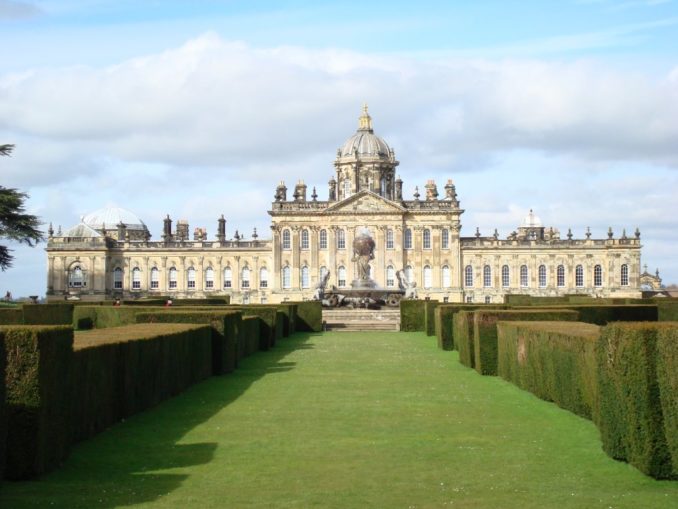
Pwojdacz (talk).Pwojdacz at en.wikipedia, Public domain, via Wikimedia Commons
Although one or two major families like the Howards (one branch of which gave rise to the Earls of Carlisle, who built Castle Howard) were still Catholic, they too mainly supported the Whiggish doctrines of liberty, balanced trade (ie trade not mainly favouring France) and social progress under the aristocracy. This led to the period known as the ‘Whig supremacy’.
Sir John has been commemorated in modern times by innumerable streets, houses, hotels, a theatre, a college at York University and even a racehorse.
Once in a while, a huge personality blasts across the national scene almost like a force of nature. Many of them are not liked by their contemporaries. Yet, described in his own day by Alexander Pope as a person of “colossal geniality”, “great good humour” and “easy-going temperament”, Vanbrugh was precisely such a man.
© foxoles 2023


